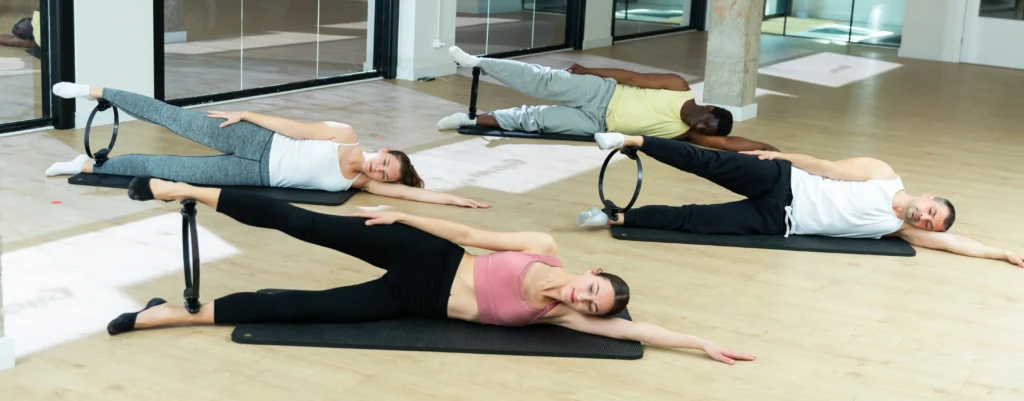
How Pilates Movement Principles Can Help Enhance Your Well-Being, Improve Functional Movement, and Fine-Tune Your Mind and Body for Better Health
Recently I was having a conversation with students in my group Pilates class, and they made the comment that they thought all Pilates exercises were supposed to be done very slowly. Now I don’t think they are always moving very slowly… but this made me realize that I haven’t educated my current beginner Pilates clients with the knowledge of the Pilates Movement Principles and how they play a key role in every workout. I used to explain these in my first day of class speech, with every new group of students… but as Pilates has gone from something that nobody had ever heard of, to something that is “familiar” as a form of exercise, there might be a bit of an assumption from some of us teaching Pilates that students know this information already. Granted students ARE using these Pilates movement principles with the cues given to find, feel, and focus on what they are doing – but students might not realize what’s happening or why, or understand the added value to paying attention to these principles during their Pilates training sessions.
As a mind-body modality, understanding the Pilates movement principles and applying them is just as important as finding and using the right muscles to do the work. So, I thought a quick review of these concepts would be a great thing to share to help with a deeper understanding of the power of the Pilates Method.
When I began learning and teaching Pilates almost 30 years ago, as a Classical trained teacher I was taught that there were 6 Pilates Principles: breathing, concentration, control, centering, precision, and flow (or rhythm).
When the Pilates Method Alliance was founded in 2001, and began the process of developing a national certification for Pilates Teachers (which was launched by the PMA in 2005, and is now the National Pilates Certification Program) the 6 principles I had learned with my Classical Pilates training were expanded upon. With this formalized national certification program in place, it was established that the Pilates Method has 3 Guiding Principles, and 8 Movement Principles.
The 3 Guiding Principles for the Pilates Method are:
- Whole Body Health – This refers to the understanding that health is a manifestation of the condition of the whole body, not just one part. It also encourages balance and well-being for physical, mental, and emotional health.
- Whole Body Commitment – This reinforces the concept of mind-body connection, and through concentration, focus, and awareness it is possible to harness the full potential of Pilates. This commitment also extends to every other aspect of one’s life to enhance overall wellness.
- Breath – Breathing is the “shower of life!” And while we don’t have to think about breathing to stay alive, conscious, and controlled breathing techniques are integral to Pilates. Deep and rhythmic breathing oxygenates the blood and promotes better circulation which improves cellular health. Good breathing habits stimulate the parasympathetic nervous system which can help reduce stress and anxiety. And coordinating breath with movement means that and every Pilates exercise “rides the breath” and this focus helps you find and use the right muscles to improve functional movement and deepen the mind-body connection.
The 8 Pilates Movement Principles are:
- Concentration – Promoting mindfulness to be aware of how the body is moving, and what muscles are doing the work (or what muscles need to release to move efficiently,) can deepen the mind-body connection, improve proprioception, and help you improve posture, body alignment, and reduce risk of injury. Concentration means you are using your brain to send the right messages to your muscles to work effectively as you do your Pilates exercises.
- Control – Control doesn’t necessarily mean you are moving slowly. Regardless of how fast or slow you do an exercise; you want to be in control of the muscles doing the work. By doing each Pilates exercise using control, you are intentionally moving the body and helping to maximize the benefits of your efforts. By staying in control there is a lower risk of injury, enhanced neuromuscular education, and the opportunity to improve motor skills.
- Centering – All Pilates exercises initiate from the core, or “powerhouse.” Which includes the abdominals, lower back, hips, and glutes. Working from the core and focusing on centering provides stability and support to enhance overall fitness, improves balance and body control, and can help eliminate aches and pains created by lack of core support (like low back pain.)
- Efficiency of Movement – The goal with all Pilates exercises is efficiency of movement. You want to learn to use only the amount of energy, or muscle support needed to do the movement with grace and control. Paying attention to your transitions (to get into and out of each exercise) are as important as the actual Pilates exercise for practicing efficiency of movement.
- Precision – Practicing precision with your Pilates exercises promotes better body awareness, improves alignment, and helps improve coordination and control. Precision helps ensure optimal benefits from each exercise and reduces/eliminates bad habits or compensations patterns. By performing each movement with accuracy and putting your body specifically where it needs to be, you are using the right muscles, and working with the Pilates movement principle of precision.
- Balanced Muscle Development – Everyone has muscle imbalances…. (A dominant side, and a weaker side… Or imbalances due to an accident or injury.) The goal of working with all the Pilates Movement Principles and applying them to every exercise is to become more aware of your imbalances, and use the Pilates exercises, springs, and equipment to help bring the weaker areas up to the level of your strengths, so the whole-body is well developed and functions optimally.
- Rhythm / Flow – Once you know the exercises in your Pilates workout – the goal is to flow from one exercise to the next to promote fluidity, grace, flexibility, and endurance. Finding your “pace” or the rhythm of your Pilates workout also helps promote strengthening and stretching the body through a full range of movement, starting from center, moving away from center, and returning to center in an almost dance-like manner which in addition to the physical health benefits, also helps quiet the mind to reduce stress and help you feel better mentally and emotionally.
- Whole Body Movement – Every Pilates exercise is a whole-body exercise. From head to toe, every part of the body has a part to play in every exercise to support good posture and improve alignment to work/release your muscles for optimal functional movement. By being able to put all Pilates principles into practice every exercise, and every Pilates workout is designed to improve whole-body health.
Applying these Pilates Movement Principles to your workouts (whether it’s a Pilates workout or any other form of exercise,) can offer profound benefits to your whole-body health and functional movement habits. A regular Pilates practice enriched by these principles can lead to a stronger core, improved flexibility, more strength, better balance and body control, improved posture and body awareness, reduced stress, and empowerment to live a healthy and active life. The impact these benefits have can extend beyond your Pilates training sessions and over time you will find that you are using these movement principles, and using your whole-body, with better support for all your daily life activities.
From a health perspective, focusing on Pilates principles ensure you are exercising safely, help reduce your risk of injury, and by encouraging better posture, body alignment, and muscle activation you can alleviate common issues like back pain, hip pain, knee pain, shoulder pain, and neck pain.
Pilates posterior-lateral breathing and using the breath with every Pilates exercise can lower stress levels to enhance overall well-being and mental health. (Check out my recent article on Pilates Breathing.)
The emphasis on the mind-body connection helps to improve mental focus and awareness which is something we don’t always think about as a benefit from physical exercise.
Incorporating Pilates Guiding Principles, and Pilates Movement Principles into your workouts goes far beyond just exercise. Pilates is a holistic approach to well-being of body, mind, and spirit. Using these movement principles helps to fuse physical strength with mental resilience, and regardless of your Pilates experience (as a novice, or advanced Pilates practitioner) putting these principles into practice can help guide you to harness the full potential of the Pilates system for improved whole-body health, less stress, and better functional movement for your workouts and ease of movement for daily life. Pilates isn’t about doing a workout to “workout.” It’s about focusing mind and body to improve how you move to boost your vitality and improve whole-body health, to enjoy a healthy and active life.
Now back to the speed of Pilates exercises which prompted this article… Yes, Rhythm/Flow is a Pilates movement principle, but I don’t push the pace for speed with new students, I let them work at their own pace – because there is so much to think about and pay attention to. I’d rather students focus on all the other movement principles first (breathing, control, concentration, centering, precision, efficient movement, whole-body movement,) and let beginner students move more slowly through the exercises than an experienced intermediate or advanced Pilates student might. I prefer to let the pace pick up naturally as confidence grows with their Pilates technique. Movements / Pilates exercises done well with the right muscles working will give you better benefits and are more effective than speedy out-of-control slop! It is best to always work at a pace that you can control your body, your movement, your springs, or whatever amount of weight or resistance you are working with.
There are so many nuances with Pilates training. And the details make all the difference in improving how you move to maximize the benefits of your workouts. By paying attention to the Pilates Movement Principles and always striving to make your last repetition of every exercise the best one you’ve ever done, you will be continuously improving your whole-body health, and always leaving your mind and body with the muscle memory of how to do the exercise well. This is a very important part of why Pilates is such a powerful mind-body exercise method for health and wellness.
*****
Stay in the loop for articles, updates, and promotions from Aliesa George and Centerworks, subscribe now to the Centerworks Wellness Success Newsletter.


0 Comments